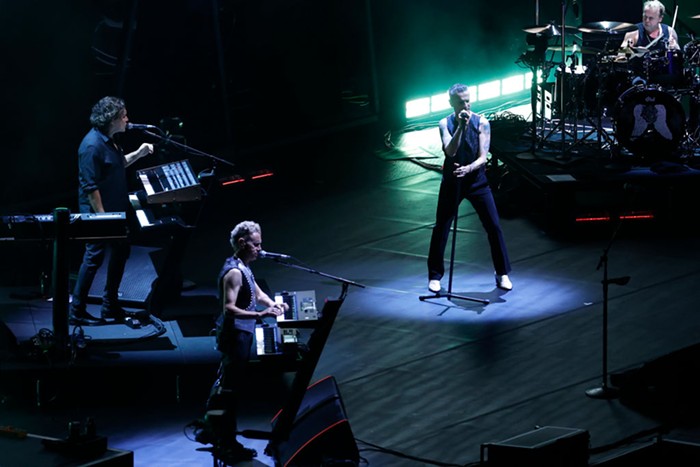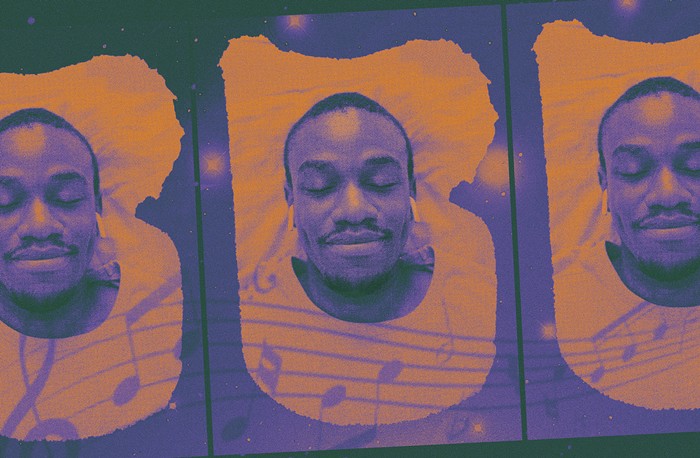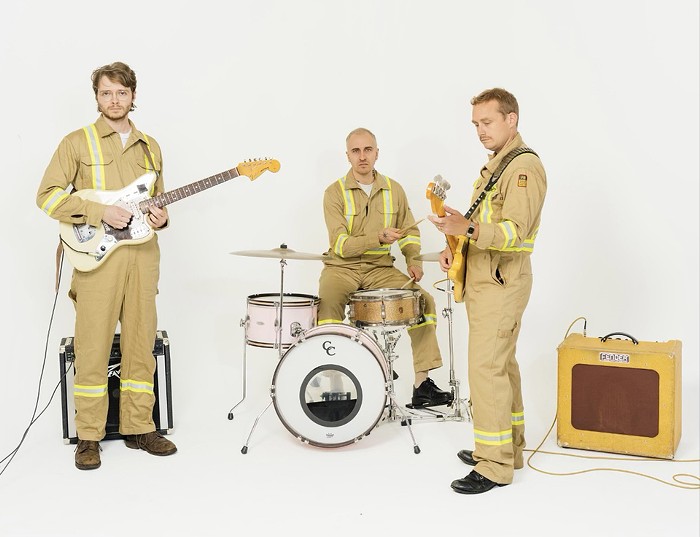In Terrance McKittrick's philosophy class at Nova High School, there aren't desks lined up in aisles, there are sofas in a semicircle. The arrangement fosters back-and-forth discussion instead of one-way lecturing, and like the rest of Nova, it's different than most high schools. A block from Country Doctor and Kingfish Cafe on 20th between Republican and East John, Nova is a refuge for students who want and need something other than the mainstream high-school setting. At Nova, students find their people and their pursuits, and participate in what interests them. Students and teachers collaborate to define a non-graded curriculum and ways to satisfy that coursework. Gay and transgender students are welcomed, protected, and given support networks.
The class I'm sitting in on is studying French philosopher Baudrillard and his simulacra theories. By the end of the hour, the class has applied the concepts to Die Antwoord, discussing how Ninja and Yo-Landi evolved themselves and took hold of their future by engaging a hyperreality. The students' interaction with the subject matter is impressive. McKittrick presents the material in an interesting way. Holograms, Richard Nixon, Michael Jackson, and Disneyland are also involved. The students seem to genuinely want to be there. I don't want to leave. Wait, when did learning like this start happening in high-school education?
After class, I head down the hall with Benjamin Verdoes (Iska Dhaaf) to a small room that houses the Beats! committee. We pop into a music room along the way, where students are playing. Verdoes has been teaching at Nova for two years. The Beats! committee (which Verdoes helped start) is a student-run music program that gives students tools to compose digital music with Ableton software. We open the door, and a student named Nash sits with headphones on, making a beat, which is fat, and nasty, and excellent. Nash is continually there, working, learning, helping others learn, and getting credit doing something he loves. Like many public high schools, Nova struggles for funding. Seattle Public Schools faces budget cuts and hiring freezes—in a city where multiple stadiums and tunnels can be funded, a school that's as important as Nova should have everything it needs. Verdoes and Nova principal Dr. Mark Perry spoke.
What makes Nova different?
Perry: We turn the paradigm of high school on its head. The key curriculum question that guides our work is "What is worthwhile to know and experience?" Relationships, student voice, and safety are three other key components that create a different learning environment that allows high-school students to be successful where they weren't successful before. This leads to many other questions, such as the purpose of high school and the quality of a high-school education, in addition to the perennial questions that plague public schooling from funding and inequitable resources, disparities in graduation rates, and the move to privatize public schooling when it has traditionally been one of the hallmarks of US democracy and social access and movement for all members of society.
Does Nova struggle with funding? Do you have everything you need and want, as far as programs and teachers and tools?
Perry: Nova is funded according to the district's Weighted Staffing Standards, which, for high schools, are built on funding the comprehensive high-school model. Compared to all high schools in Seattle Public Schools, Nova's average cost per student is just below the district average. Nova has a high percentage of students with special needs, and our special education population is significantly higher than the district average. Special education is funded separately from general education. Based only on our general education student numbers, Nova is the lowest cost per student of all the SPS high schools.
Nova almost had to lose two teachers recently. But they were able to stay. What happened?
Perry: WSS funding is primarily based on numbers of full-time students. Most schools, including all of the comprehensive high schools, have assignment zones, so their enrollments are relatively predictable. Nova is an option school, and we draw from the entire city—we have to recruit our student body through publicizing our school. We also take transfer students from other high schools. The cut date for school funding is the October 1 count. Nova's longitudinal data shows that we have made our enrollment numbers every October 1 for the past five years. Typically, our projected numbers are lower in the spring, since students will enroll in Nova through the month of September. In terms of our budget for upcoming years, it is finalized in March based on our October 1 count, not our May numbers as is the case with assignment schools, since their numbers are predictable and changes show up sooner than they would at a school like Nova. This year, enrollment services presented our lower projected numbers to the new budget people and proposed that we lose two staff members based on our May numbers and not our October count. We had to appeal, and based on our longitudinal numbers we were able to win the teachers back. This is still an issue, since enrollment services is still pushing that we lose staff.
Is that a common thing to happen, to have teachers and programs threatened to be taken away?
Perry: It's more common than it should be. There has been an incredible amount of turnover that past five years in the central administration. We are now on our third budget director in these five years, and the institutional memory gets lost, so decisions are made with available information that is selectively presented to them.
What things would you like to see change as far as the funding issues go?
Perry: Fair, equitable, and transparent funding is an issue throughout the district. SPS tends to rely on a "one size fits all" model in practice, with exceptions made on a case-by-case basis, and not all the money that goes to schools is counted in WSS, such as grant monies and PTSA (Parent Teacher Student Association) and school foundation money. The result is persistent inequitable funding.
Besides Beats!, what are some of the other student-run committees?
Perry: We are willing to try almost any initiative from students. The key is their involvement and whether students are willing to drive the work that needs to be done. There's also the Naked Truth, a spoken word project, and the student-initiated and -facilitated trans center—the only one in a public high school anywhere in the country. It's a gender and sexuality activism group, currently known as Action Faction—it has developed and provided resources for LGBTQ youth for 13 years here at Nova. In addition to running educational workshops and gender fluidity celebrations, Action Faction has created sexual health resource lockers and the gender nonconforming resource center, formally known as the trans center. Compression shirts, breast forms, clothing, and menstrual supplies that are less likely to out the users' assigned birth gender are provided. We've also created and maintained gender-inclusive bathrooms at Nova, formally known as non-gender, and advocated within the school district for inclusive gender policies for all high schools.
What things does Nova want and need now?
Perry: Our greatest need is recognition and support for the work we do at Nova. Our curriculum is set up to serve all students, especially students who want to choose an alternative learning environment to the comprehensive high school. Three of the past five years, we have been recognized by OSPI for our extended graduation rates, but all the emphasis within SPS is on four-year graduation rates. We are currently designated as a creative approach school, which we characterize as being an "incubator of inquiry and innovation," but we get more recognition for our innovative work with students outside Seattle and Washington State than we do in Seattle or in SPS. SPS has sent teachers to California to learn project-based teaching and recently sent teachers to New York to learn performance assessment. We have been doing these practices for a dozen years, yet we seldom get asked or visited to learn about what we do or what we have learned through implementing inquiry, project, and problem based learning, or performance assessment. With more recognition, we would have the ability to focus more on our work here at Nova and less on meeting compliance issues that do not fit our model of teaching and learning. Another example is that the Seattle Times published a list of all the middle and high school discipline disproportionality rates a few months ago. Only one school did not have a disproportional discipline rate—Nova—yet no one from SPS has asked why our focus on redemptive and restorative justice/discipline works and what it takes to make it work.
Could you talk about the disproportional discipline rate a little more? What did the Times article say?
Perry: The disproportional discipline rate is based on the differences between suspensions and expulsions for white students and students of color. It usually focuses on the rate difference between black and white students. In 2012–13 in SPS, black students throughout K–12 grades were suspended or expelled at a rate of 5:1 greater than white students. For middle and high schools, what the Seattle Times charted was the school-by-school rate of students of color versus white students in the rate of suspensions and expulsions, taking into consideration the total numbers of black and white students in an individual school. Nova was the only middle or high school in the chart that did not have a disproportional discipline rate.
Since SPS didn't ask, allow me. Why does focus on redemptive and restorative justice/discipline work?
Perry: There is a long and a short answer to these questions. The shorter answer is that with teenagers, respect and understanding are the key components in discussing any issues where students make poor choices. This requires a level of respect between the students and adults, at the high-school level, that is not usually evident in most schools, to make it work. Safety is essential for students to feel physically, socially, and emotionally safe enough for learning to take place in a school. Most schools rely on a strict set of rules and consequences. Some schools have begun to institute a type of restorative justice/discipline, and it is a step forward, but these are still often built on a set of rules and policies set by adults that the adults believe are needed to run the school smoothly and keep it safe. We involve students in setting our policies and rules—as well as in-school consequences when appropriate—which usually focus on school and/or community service. When the rules and policies are clear and make sense to students, we find that they will support them and help other students understand and support them. The redemptive aspect is often missing in even restorative justice/discipline programs. This aspect focuses on students learning to make good choices, learning from poor choices, and engaging in active conversations about what they have learned in each situation, especially where they may have made poor choices. Underlying our system is the belief that, given the opportunity, most youth will make positive choices when given good information, and through this process they learn the tools to ask questions and evaluate situations so they can minimize their poorer choices over time.
Benjamin, what made you want to help start the Beats! program?
Verdoes: I would pass by groups of students freestyling and beatboxing in the hallways between classes and after school. It occurred to me that they should have an outlet for their art and a place to develop their skills, so I suggested that they create a committee. I had just been starting to learn how to make beats myself, and I thought it would be a good way to connect with my students. Nova has a committee system where students and staff can create learning groups based on their interests or to satisfy a need in the community. So we created Beats! committee. Any time you give young people access to tools that interest them, you create opportunities for life-changing experiences and positive involvement in community. The group became tightly knit, and most of the learning exchanges happened between students. One of our students is really into house music, and he taught several others how to approach that genre. A few other students are really into making trap beats, so they spread their technique and knowledge. Students share files and sounds, and when they collaborate, the results are beautiful. Most of what I taught them was about the music industry, booking shows, fundraising, and promotion.
Do you need more funding for the program? If so, how much, and how do you think it should be funded?
Verdoes: Funding is almost always an issue in public education. It would be awesome to build a fully functional recording studio in the school. Beats! literally operates out of a big closet at the moment; it has no windows and is not soundproof. Furthermore, it would be great to bring in more guest teachers from the music community. It's nice to give these teaching artists stipends. Folks can donate equipment, money, and/or music software. I can be reached at: beverdoes@seattleschools.org.
How and why do you think Nova helps students who want something different than what the conventional high school offers?
Verdoes: I think everyone wants to learn, live, and work in environments where they feel like they are accepted and respected. There are so many students who don't feel safe being themselves in mainstream schools. Some of my most creative students felt stifled in other programs—academically and as individuals. Nova gives students the freedom to explore what they want to learn and who they want to be. Every person I know who has come to visit the school says, "I wish I could've gone to a school like this."
How is it that Seattle can get tunnels, but education struggles to be funded? What needs to change in order to get education the funding it needs?
Verdoes: There are schools in the district that receive adequate funding, whether that is through zoning, grants, PTA fundraising, or a combination of these. The issue is immense and complex, but ultimately it comes down to wealth. Our schools function in a system that is deeply burdened by institutionalized racism, classism, and federal funding issues. Seattle is considered a progressive city. In many ways, it is, though it is clearly segregated and impacted by disparity.
What's happening on June 10 for the Beats! party?
Verdoes: We're releasing a compilation of songs that we've put together, so we'll be setting up a sound system and playing the music we've created. It's a celebration of the end of an era and the beginning of a new one. ![]()



















